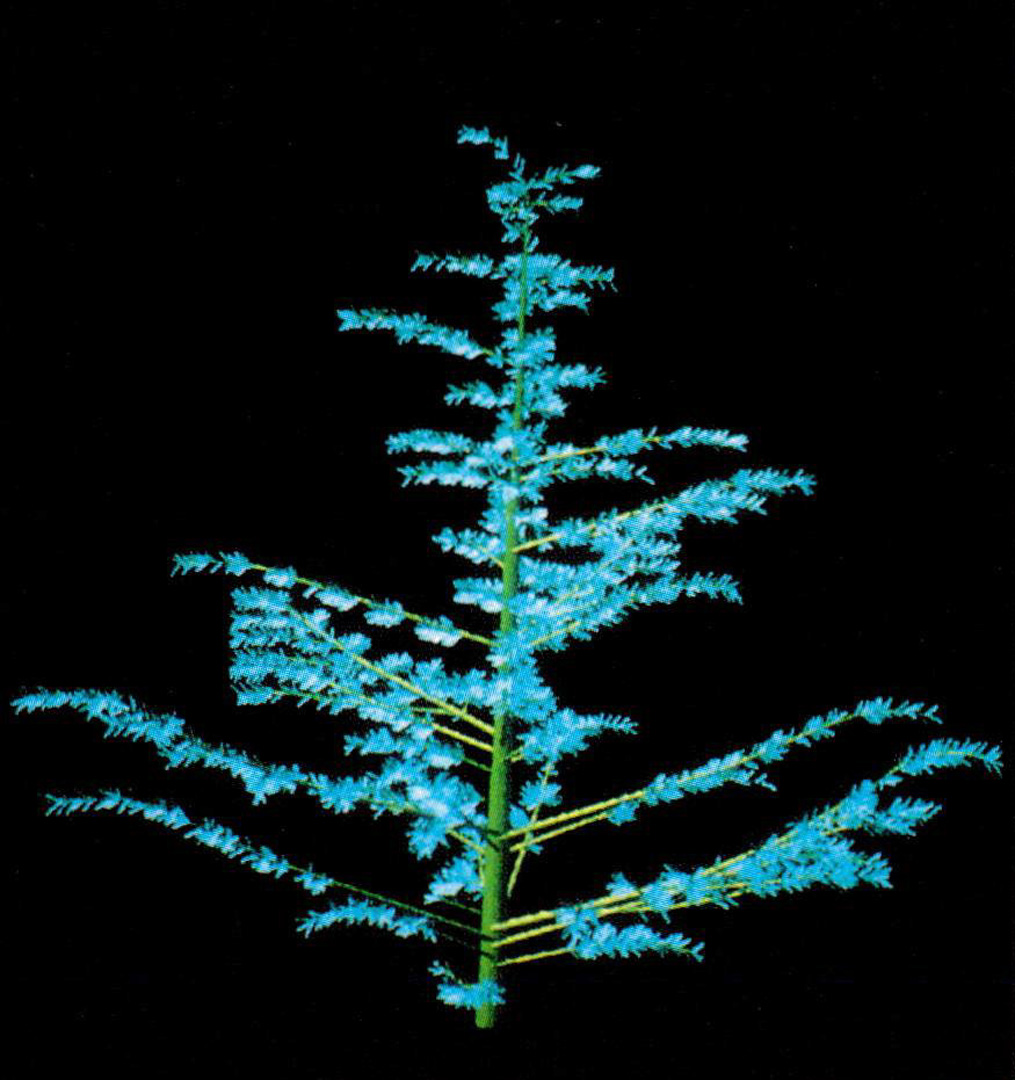“Plant models faithful to botanical structure and development” by de Reffye, Edelin, Françon, Jaeger and Puech
Conference:
Type(s):
Title:
- Plant models faithful to botanical structure and development
Presenter(s)/Author(s):
Abstract:
Some very impressive results have been obtained in the past few years in plants and trees image synthesis. Some algorithms are largely based on the irregularity and fuzziness of the objects, and use fractals, graftals or particle systems. Others focus on the branching pattern of the trees with emphasis on morphology. Our concern here is the faithfulness of the models to the botanical nature of trees and plants. We present a model which integrates botanical knowledge of the architecture of the trees: how they grow, how they occupy space, where and how leaves, flowers or fruits are located, etc. The very first interest of the model we propose is its great richness: the same procedural methods can produce “plants” as different as weeping willows, fir trees, cedar trees, frangipani trees, poplars, pine trees, wild cherry trees, herbs, etc. Another very important benefit one can derive from the model is the integration of time which enables viewing the aging of a tree (possibility to get different pictures of the same tree at different ages, accurate simulation of the death of leaves and branches for example). The ease to integrate physical parameters such as wind, the incidence of factors such as insects attacks, use of fertilizers, plantation density, and so on makes it a useful tool for agronomy or botany.
References:
1. Aono M., Kunii T. L., “Botanical Tree Image Generation” IEEE Computer Graphics and Applications, vol. 4, No 5, 1984, pp. 10-33.
2. Bell A., “Computerized Vegetative Mobility in rhizomatous plants”, in Automata, Languages, Development, Lindenmayer A. & Rozenberg G. (Eds.), North-Holland, 1976.
3. Bloomenthal I., “Modeling the Mighty Maple”, Computer Graphics, vol. 19, No. 3, 1985, pp. 305-311.
4. Edelin C., Larchitecture Monopodiale: l’Exemple de Quelques Arbres d’Asie Tropicale. These de Doctorat es Sciences, Universite des Sciences et des Techniques du Languedoc, Montpellier, France, 1984.
5. Eyrolles G., Francon J., Viennot G., “Combinatoire pour la Synthese d’Images Realistes de Plantes”, Actes du Deuxieme Colloque Image, CESTA, 1986, pp. 648-652.
6. Fischer J. B., Honda H., “Computer Simulation of Branching Pattern and Geometry in Terminalia (Combretaceae), a Tropical Tree”, 1977.
7. Fournier A., “Prolegomenon”, Unpublished course notes, Fournier A. ed., The Modeling of Natural Phenomena (SIGGRAPH’87 course notes #16, Anaheim, CA, July 1987) pp. 3-37.
8. Frijters D., Lindenmayer A., “A Model for the Growth and Flowering of Aster Novae-Anglia on the Basis of Table (0,1)-Systems”, in L-Systems, Rozenberg G., Salomaa A. (Eds.), LNCS, 15, Springer-Verlag, Berlin, 1974, pp. 24-52.
9. Halle, Oldeman, Tomlinson, Tropical Trees and Forest: an Architectural Analysis, Springer-Verlag, Berlin/Heidelberg/New-York, 1978.
10. Jaeger M., Reprdsentation et Simulation de Croissance de V(gdtaux, These de Doctorat, Universite Louis Pasteur, Strasbourg, France, Dec. 1987.
11. Kawaguchi Y., “A Morphological Study of the Form of Nature”, Computer Graphics, vol. 16, No. 3, 1982, pp. 223-232.
12. Lienhardt P., “Free-form Surfaces Modeling by Evolution Simulation”, to appear, Proceedings Eurographics’88.
13. Lindenmayer A., “Paracladial Systems”, in Automata, Languages, Development (Lindenmayer A., Rozenberg G. Editors), North-Holland Publishing Company, Amsterdam/New-York/Oxford, 1976.
14. L~ck, “Elementary Behavioural Rules as Foundation for Morphogenesis”, J. Theor. Biol., 54, 1975, pp. 23-24.
15. Oidemann R.A.A., “L’architecture de la Foret Guyanaise”, Memoire 73, ORSTOM, 1974.
16. Oppenheimer P. E., “Real Time Design and Animation of Fractal Plants and Trees”, Computer Graphics, vol 20, No. 4, 1986, pp. 55-64.
17. Prusinkiewicz P., “Applications of L-systems to Computer Imagery”, in Proceedings of the Third Workshop on Graph Grammars and their Applications to Computer Science, Warrenton, Dec. 1986, pp. 534-548.
18. Reeves W. T., Blau R., “Approximate and Probabilistic Algorithms for Shading and Rendering Structured Particle Systems”, Computer Graphics, vol. 19, No. 3, 1985, pp. 313-322.
19. Reffye (de) P., Modrlisation de l’Architecture des Arbres Tropicaux par des Processus Stochastiques, These de Doctorates Sciences, Universite de Paris-Sud, Orsay, France, 1979.
20. Reffye (de) P., “Moddle Mathrmatique Alratoire et Simulation de la Croissance et de rArchitecture du Cafrier Robusta”, Premiere partie, Cafd-Cacao-Thd, vol. 25, No. 2,1981, pp. 83-104. Deuxieme pattie, Cafd-Cacao-Thr, vol. 25, No. 4, 1981, pp. 219-230. Troisieme partie, Cafd-Caeao-Thd, vol. 26, No. 2, 1982, pp. 77-96. Quatribme pattie, Cafd-Cacao-Thr, vol. 27, No. 1, 1983, pp. 3-20.
21. Reffye (de) P., Edelin C., Jaeger M., Cabart C., “Modelisation de l’Architecture des Arbres”, in Proc. Int. Conf. “The tree”, Montpellier, Sept. 85.
22. Rouane, “Un Modele de la Ramification de la Croissance Vegetale en tant qu’Image de la Differentiation Cellulaire”, Comptes-Rendus de l’Academic des Sciences, Paris, T. 285, 26, Sept. 1977.
23. Smith A. R., “Plants, Fractals and Formal Languages”, Computer Graphics, vol. 18, No. 3, 1984, pp. 1-10.
24. Smith A. R., Unpublished course notes, Fournier A. ed., The Modeling of Natural Phenomena (SIGGRAPH’87 course notes #16, Anaheim, CA, July 1987).
25. Stoker J.J., Nonlinear Elasticity, Gordon et Breach, New York, NY, 1968.




